Understanding Windsurf Foil Boards: A Detailed Overview
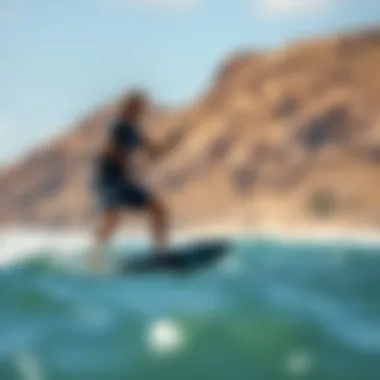
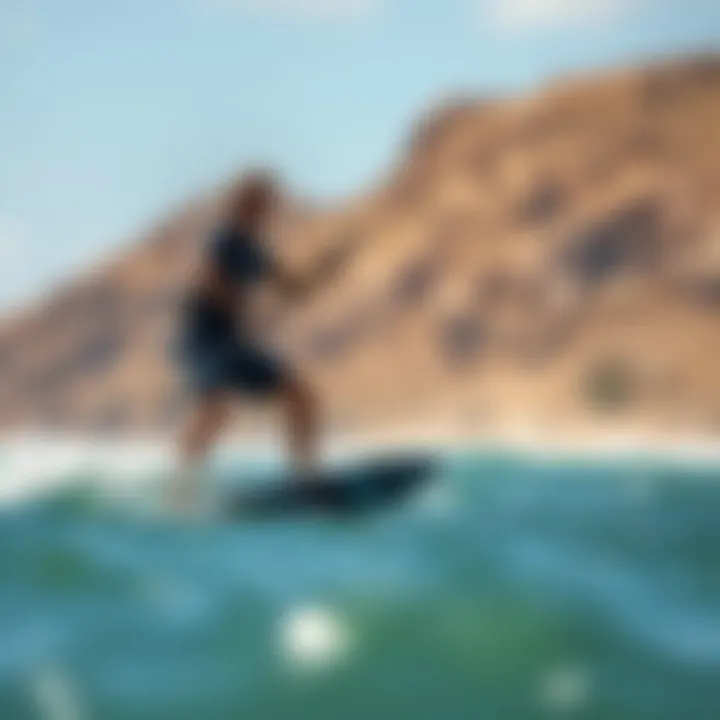
Intro
Windsurf foil boards, a captivating blend of windsurfing and hydrofoiling, are stirring excitement among enthusiasts and hobbyists alike. The thrill of gliding over water with minimal drag offers a refreshingly unique experience. Unlike traditional windsurfing, these boards elevate riders above the water’s surface, leading to a smoother ride even in choppy conditions. More than just a trend, foil boards are changing how we perceive windsurfing, bringing a level of speed and agility that is both exhilarating and rewarding.
For many, diving into the world of windsurf foil boards can seem daunting. There’s a heap of jargon, components, and techniques to unpick. This exploration goes into the nitty-gritty aspects like the design features that set foil boards apart, the essential gear you’ll need, and valuable techniques for riding. Whether you are a novice who can barely balance on a board, or an experienced rider looking to refine your skills, there’s something here for everyone.
As we embark on this journey, we’ll take a close look at the fundamental gear involved in windsurf foil boarding, essential tricks and tips that can lift your performance to new heights, and what the future holds for this thrilling sport. So, strap your sails, it’s time to ride the wind!
Understanding Windsurf Foil Boards
Understanding windsurf foil boards is essential for anyone who wants to dive into the exciting realm of windsurfing. These boards are not just simple pieces of equipment; they represent a significant evolution in how we harness wind for sport. Foil boards allow riders to glide above the water, reducing surface drag and opening up new possibilities for speed and maneuverability. One can argue that grasping the concept of foil boards is akin to learning to drive a fancy sports car—it's not just about the ride, but how you interact with the environment around you.
What is a Windsurf Foil Board?
A windsurf foil board is a specialized board that features a hydrofoil attached under the water. This hydrofoil consists of a wing-like structure that generates lift when a rider accelerates, lifting the board above the surface of the water. Once airborne, the board experiences a significant decrease in resistance, leading to a smoother ride and allowing it to glide effortlessly even in lighter winds.
These boards come in various sizes and shapes, each designed for specific conditions and rider preferences. Whether one is an adventurous beginner or a seasoned pro, understanding the machinery behind windsurf foil boards is key. It’s like familiarizing oneself with the inner workings of a watch; knowing the components enhances appreciation and performance.
Historical Evolution of Foil Boards
The journey of foil boards traces back to the early 20th century, with the first prototypes created by pioneering inventors. However, it wasn’t until the late 1970s and early 1980s when the concept gained traction among enthusiasts. Notably, it was Hawaiian windsurfer Doug Frier who made waves in the windsurfing community by creating the first functional hydrofoil. This moment marked a turning point—foiling became more than a concept; it evolved into a legitimate sport.
Following Frier’s groundwork, manufacturers began to experiment with different materials and designs, refining the hydrofoil technology over the years. The introduction of lightweight and durable composites in the 1990s revolutionized the sport further, making foiling more accessible and appealing.
Today, advances in technology continue to push boundaries. Riders now have access to a range of options—some boards are specifically built for flat water, while others cater to wave conditions. As the sport grows, so does the creativity of the riders. Every year, events around the world showcase innovations in technique and design, honoring the roots of foiling while looking toward the future.
"The evolution of windsurf foil boards isn't just about equipment; it's about unlocking new ways to connect with nature and challenge personal limits."
In summary, understanding windsurf foil boards opens up a world full of possibilities, unraveling both historical heritage and modern advancements. It's a journey worth exploring, whether you're just starting out or an old hand looking to ride the wind in new ways.
Key Components of a Windsurf Foil Board
Understanding the key components of a windsurf foil board is essential for both novices and seasoned riders. Each segment of a foil board plays a vital role in how the overall system performs on the water. From the foils that lift the board above the wave to the shape and size that contribute to stability and control, these elements can make a world of difference in your windsurfing experience.
Foils: Types and Materials
The foils are arguably the heart of the windsurf foil board. Their design and material greatly influence performance, handling, and the overall feel of your ride.
Aluminum vs. Carbon Foils
When it comes to choosing between aluminum and carbon foils, riders often weigh their options based on weight, strength, and cost. Aluminum foils are known for their durability, making them a solid choice for beginners who might experience a few bumps and scrapes while learning. On the flip side, carbon foils offer a remarkable weight-to-strength ratio. This characteristic allows for increased speed and agility on the water, but they do come at a heftier price.
"While novices might lean towards aluminum due to its resilience, experienced riders often swear by the performance edge that carbon provides."
Carbon foils tend to be snappier and offer quicker response times, which can significantly enhance performance in advanced maneuvers. However, their fragility makes careful handling a must. On the other hand, aluminum, while heavier, can withstand harsher conditions, making it a more forgiving option in rough waters.
High-aspect vs. Low-aspect Foils
Delving into the specifics of foil shapes, there are two prominent designs known as high-aspect and low-aspect foils. High-aspect foils feature elongated wings that provide improved lift and speed. They excel in gliding over longer distances, drawing enthusiasts who crave performance and efficiency.
Conversely, low-aspect foils are characterized by a wider wingspan and are generally more stable at slower speeds. This stability can be incredibly advantageous for beginners looking to master the basics without feeling overwhelmed by instability.
While high-aspect foils can dramatically elevate speed, they are less forgiving on the turns. Low-aspect models may not reach the same blistering speeds but are approachable for those just getting their feet wet—quite literally.
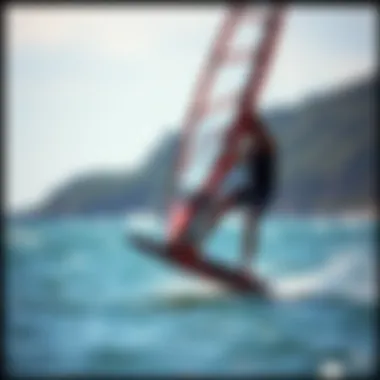
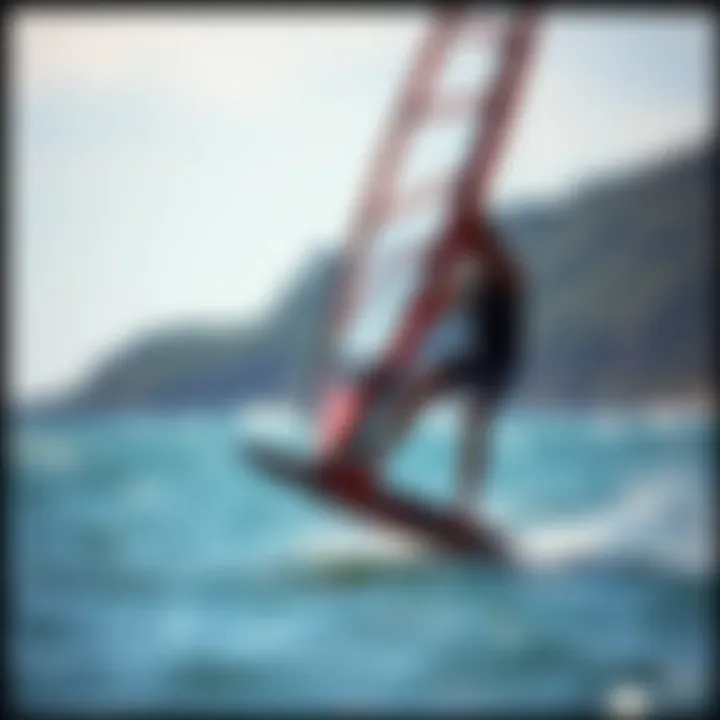
Board Construction: Shape and Size
Board construction is equally significant. It dictates how a rider navigates the water and can affect the overall enjoyment and performance.
Volume and Buoyancy Considerations
A critical factor in the choice of board is its volume, which directly relates to its buoyancy. The right volume for a rider depends on their weight and skill level. Boards with greater volume generally offer more buoyancy, making them easier to lift and ride, especially for newcomers who may struggle with balance.
Too much volume, however, can lead to excessive drag, complicating speed and maneuverability. Thus, a delicate balance must be struck based on personal attributes and goals. Riders who anticipate advancing may choose marginally less buoyant boards to encourage progression in their skill set.
Width and Length Dynamics
The physical dimensions of a board—width and length—also hold significant sway over handling and performance. Wider boards provide more surface area, which enhances stability. This feature can be particularly beneficial for lighter riders and beginners who require that extra stability while getting used to the foil system.
On the other hand, length affects the straight-line performance. Longer boards typically allow for more glide, which can be advantageous in light wind conditions, leading to a more enjoyable ride. However, they may sacrifice some maneuverability, especially in tight turns, which can be a hurdle for those eager to try advanced techniques.
Each decision point in this construction process contributes significantly to the riding experience. Being equipped with the knowledge of these components empowers riders to make informed choices, ultimately leading to a more enjoyable time on the water.
Performance Factors in Windsurf Foil Boarding
When it comes to windsurf foil boarding, understanding the performance factors is crucial. These elements directly impact how smoothly and efficiently a rider can maneuver on the water. Factors like lift, drag, sail size, and rigging techniques play essential roles in ensuring that riders can extract the best performance from their equipment. Without a grasp of these concepts, even the most advanced gear may not deliver the desired thrills or safety.
Understanding Lift and Drag
Lift and drag are two fundamental aerodynamic forces that every windsurfing enthusiast should be familiar with. To put it simply, lift is what gets you up and out of the water, while drag is the resistance that threatens to hold you back. In foil boarding, achieving the right balance between these forces is what allows riders to glide effortlessly over the surface instead of battling against it.
Lift
Lift occurs when the hydrofoil—a wing-like structure submerged in the water—creates an upward force as water flows over it. The shape and angle of the foil dramatically influence this lift. For instance, foils with higher aspect ratios are known for producing increased lift at lower speeds. This means that as a rider picks up speed, they can gain height quickly, transitioning from operating at the water’s surface to soaring above it.
Drag
Conversely, drag is caused by the water's resistance against the foil and board. High drag can hinder performance, making the ride sluggish. It's influenced by various factors, including the foil's surface area, the rider's position, and even water conditions. Lower drag allows riders to maintain speed with minimized effort. Riders must fine-tune their setup, focusing on streamlined designs and optimal positioning to enhance lift while reducing drag.
One effective way to minimize drag involves using a smaller foil in gusty wind conditions or honing in on more advanced riding techniques. So, when footing on your board, every little adjustment counts.
Sail Size and Rigging Techniques
The size of your sail is another pivotal factor in performance. It determines how much power you can harness from the wind, allowing you to propel forward. For beginners, opting for a larger sail can be beneficial, providing more lift and facilitating easier take-offs. However, experienced riders may prefer a smaller sail for added maneuverability, especially when intending to perform tricks or navigate through rougher waters.
Sail Size Consideration
- Beginner Riders: Generally benefit from larger sails (around 6.0 - 8.5 square meters), which assist them in learning to harness the wind's power effectively.
- Advanced Riders: Often choose smaller sails (around 4.0 - 6.0 square meters) as they provide better control and handling, particularly during high-speed maneuvers.
Rigging techniques are equally paramount for optimizing performance. Properly rigging a sail means harnessing the wind's energy effectively.
- Mast Placement: The height of the mast can alter the angle of the sail, impacting its efficiency.
- Downhaul and Outhaul: Achieving the right tension in the sail makes it much easier to catch the wind while minimizing drag. Proper tension allows the sail to maintain its shape, delivering better performance throughout various conditions.
In summary, understanding lift and drag alongside choosing the right sail size and mastering rigging techniques are fundamental in optimizing windsurf foil boarding performance. These principles not only enhance the enjoyment of the sport but also increase safety by fostering better boat control and stability on the water.
"In every windsurf session, the nuances of lift and drag can define your ride from exhilaration to exhaustion."
For additional tips on rigging and optimizing your windsurfing experience, you can visit sources such as Wikipedia or forum discussions on Reddit.
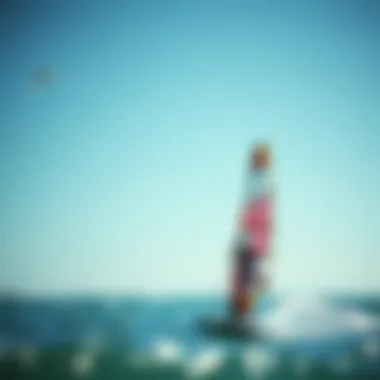
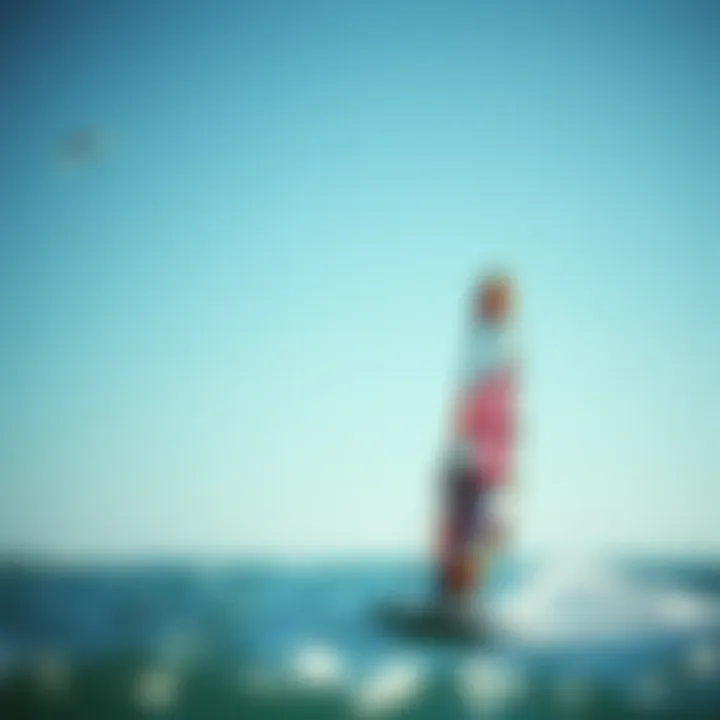
Technique and Skills in Windsurf Foiling
Windsurf foiling is not just a sport; it's an art form that combines dynamism with a hint of grace. Understanding the technique and skills involved in windsurf foiling is paramount, as these elements can significantly influence performance on the water. Grasping the nuances of technique can open a whole new world of possibilities, transforming a good ride into an exhilarating experience.
Whether you're gliding smoothly or zipping through the waves, having the right technique is what separates the novices from the seasoned riders. Proper weight distribution, balance, and timing when maneuvering can lead you toward significant improvements in your foiling journey. For beginners, honing these basics is crucial, while experienced riders often focus on enhancing their abilities to tackle advanced maneuvers.
Basic Foiling Techniques
In the realm of windsurfing, basic foiling techniques serve as the foundation for success. Learning how to foil requires practice and patience, but the rewards can be thrilling. The journey begins with mastering the correct stance. The rider should spread their feet out and maintain a low center of gravity to remain stable on the board as the foil begins to lift off the water.
Additionally, one of the first techniques to grasp is the transition from flat water to foil, a skill that is critical for new riders. Timing the moment the sail depowers and shifting your weight backward can create lift, making the experience smoother.
Moreover, as you become more comfortable, practicing sailing in a straight line becomes essential. This serves not only to build confidence but also to help you learn how to control the foil’s lift by adjusting your body position, the mast angle, and sail tension. Understanding when to shift weight and maintaining momentum are critical to achieving that magical moment when you are skimming just above the surface.
Advanced Maneuvers for Experienced Riders
For those ready to take their skills up a notch, advanced maneuvers change the game entirely. Here, riders enter a world full of creativity and expressive performances. Two notable techniques worth mentioning are carving turns and jumping tricks.
Carving Turns
Carving turns is an advanced maneuver that highlights the elegance of windsurf foiling. The essence of carving lies in the smoothness and fluidity of the turn—it's all about maintaining speed while making those critical adjustments in your body weight. A well-executed carve not only reflects mastery over your board but also showcases your understanding of hydrodynamics.
The technique requires leaning into the turn while keeping your weight balanced over the foil. This pull creates a more efficient arc that allows for better acceleration out of turns, making it a favorite for many riders. However, too much weight shift can lead to a loss of balance, potentially causing a tumble.
Jumping and Tricks
Jumping and tricks elevate the excitement in windsurf foiling. This technique allows riders to incorporate tricks, spins, and aerial maneuvers into their routine, showcasing creativity. Jumping involves carefully timing your approach and managing buoyancy so that you can take off just right. The key characteristic of this technique is the controlled lift, which directly influences how high you soar.
With jumping, the unique feature comes from the combination of speed and skill: you need to gain sufficient speed before executing the jump. Not all jumps are created equal; some require specific skills that can be physically demanding. Riders often work to perfect a variety of jumps, from the simple pop to more complex rotations. While risky, this element adds an additional layer of excitement in foil windsurfing.
Choosing the Right Windsurf Foil Board
Selecting the appropriate windsurf foil board is a crucial decision that can significantly influence your riding experience, especially for beginners and experienced riders alike. The right board not only enhances performance but also ensures safety and enjoyment while navigating the water. Understanding different aspects of board design—like size, shape, and materials—can help you make an informed choice that aligns with your skills and goals.
Factors to Consider for Beginners
For those just stepping into the world of windsurfing, choosing the right foil board can feel like finding a needle in a haystack. But it doesn't have to be that daunting. Here are some essential factors to keep in mind:
- Volume and Buoyancy: An ample volume is vital for beginners. Boards with higher volume float better, making it easier to start sailing without immediately sinking. Look for boards in the 120 to 180-liter range, as they tend to support novice riders well.
- Stability: Stability is paramount. Opt for a wider board that offers more surface area. This feature can contribute significantly to balanced riding, reducing the cha=ance of falls and discomfort while learning basics.
- Foil Compatibility: Ensure the board you choose is compatible with beginner-friendly foils. Some foils offer more lift at lower speeds, making it easier to get up and flying.
- Weight Capacity: Consider your weight in relation to the board’s weight capacity. Choose a board that has a capacity above your own weight to avoid compromising performance.
- Ease of Use: Some boards come with instructional materials or beginner stability features. Look for those options, which can be a blessing when mastering techniques.
"Pick a board that will help you ride the wind instead of fighting against it."
Gear Options for Advanced Riders
For the seasoned windsurfer, the gear selection process takes on a different perspective. You're not just looking for any board; you want one that enhances performance while enabling advanced maneuvers. Here’s what to look for:
- Performance Boards: Lightweight models made from carbon fiber are typically favored. They offer improved stiffness and responsiveness, which is essential in demanding conditions. Brands like Slingshot and Starboard feature some of the best performance boards on the market.
- Size and Shape: Advanced riders often prefer boards that are narrower and longer, allowing for quicker transitions between maneuvers. This design helps in tackling high winds and making sharp turns with precision.
- Customization Options: Advanced users should consider boards that offer adjustable foils. This allows for tuning the setup based on wind conditions and personal preferences, giving experienced riders the flexibility to push their limits.
- Maneuverability: Some boards are specially designed for specific moves like jumping or carving. If you’re looking to perform tricks or jumps, ensure your board design supports such activities.
- Technical Features: Increased surface area on the fuselage can mean better handling in rougher waters. Keep an eye out for gear that has advanced features that would make it easier to carve turns or leap over waves.
In the end, choosing the right windsurf foil board is about finding a balance between performance and comfort. Whether you're just starting out or are a seasoned pro, the right board can make all the difference in your windsurfing adventures.
Safety and Maintenance in Windsurf Foiling
In the world of windsurfing, especially when you dive into the realm of foiling, safety and maintenance take center stage. Understanding these two elements is crucial for not only prolonging the life of your equipment but also ensuring a safe and enjoyable riding experience. With the right knowledge, riders can navigate the waters efficiently while minimizing risks, ultimately enhancing their overall performance in this thrilling sport.
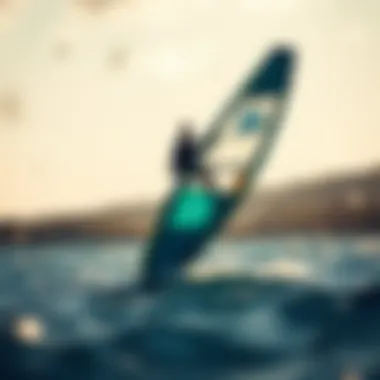
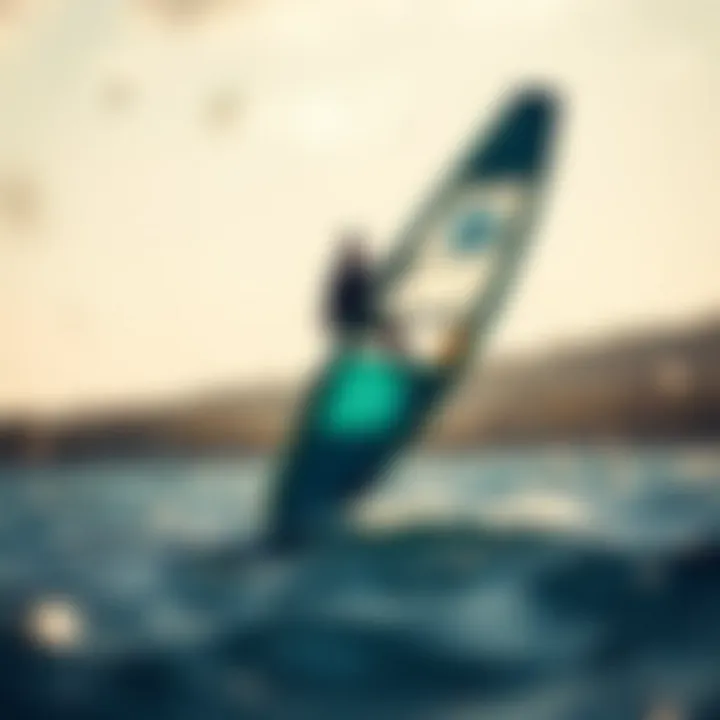
Safety Gear and Precautions
When gearing up for a session, safety should be the top priority. The ocean can be unpredictable and knowing the right gear helps you ride with ease of mind. Riders should consider the following safety equipment:
- Impact Vest: A padded vest offers crucial protection during falls, especially when speed picks up.
- Helmet: Head injuries are a serious concern in water sports. Using a good helmet can prevent serious injuries if a rider falls or collides with another object.
- Wetsuit: Not only does it keep you warm, but it also offers an additional layer of protection against scrapes and rough water conditions.
- Leash: An often overlooked item, a leash connected between your board and your ankle ensures you don’t lose your gear in the water after a wipeout.
Basic precautions do go hand-in-hand with gear. Before hitting the water, it’s essential to check weather conditions, tidal patterns, and waves. This knowledge assists you in understanding your environment and preparing for any unforeseen challenges.
Routine Maintenance Tips
Maintaining your windsurf foil board ensures longevity and optimal performance out on the water. Here are a few essential maintenance routines to follow:
Foil Care
Regular care of your foil is not just about aesthetics; it plays a significant role in ensuring efficient performance. A well-maintained foil reduces drag and increases lift, facilitating smoother rides.
- Cleaning: After each session, rinse the foil with fresh water to remove salt and sand. This simple step prevents corrosion and wear from settling in.
- Inspection for Dents or Dings: Check for minor damages. Even a small dent can alter performance. Staying vigilant about these can save headaches later.
- Storage: Keep your foil in a dry and cool place. Humid environments can lead to rust and degradation of materials.
Foil care is popular among serious riders as it yields significant performance benefits. An intact foil translates to better efficiency in windy conditions, which is essential for achieving those thrilling rides that foil boarding is known for.
Board Inspection
Similar to the foil, the board itself requires regular inspections. Ensuring that your board is in tip-top shape contributes to your safety and enjoyment.
- Check the Bottom for Scratches: The underside of your board is susceptible to scratches from rocky surfaces or other debris in the water. While minor scratches may not affect performance drastically, deep ones can lead to water ingress.
- Hardware Inspection: Ensure that the foot-straps and mast tracks are secure. Regularly check the screws to prevent any loose fittings while you’re riding.
- Inflation for Air Boards: For inflatable boards, ensure they are correctly inflated to provide maximum buoyancy and performance. Under-inflation can lead to a poorly performing board, making it hard to ride.
Settling into a routine of inspecting your board not only helps in identifying small issues before they become significant concerns but also maintains your standing confidence on the water. Keeping up with these inspections ensures safe foiling, allowing you to focus on skill development rather than worrying about the integrity of your gear.
Always remember, the ocean is both beautiful and dangerous. Preparedness is your best ally. The right gear and consistent maintenance can make all the difference in enjoying your windsurfing journey.
The Future of Windsurf Foil Boards
The world of windsurfing is always on the move, with advancements in technology and design shaping its future. As the popularity of windsurf foil boards continues to grow, it is essential to understand the significance of these developments. Wind foil boards are not just about catching wind; they represent a fusion of performance, accessibility, and sustainability that could revolutionize the sport for many.
In particular, innovations in windsurfing technology and sustainability considerations reflect a shift towards more eco-friendly practices. This transformation not only enhances the performance of the boards but also makes an impression on the environmental footprint of the sport. Forecasting the future of windsurf foil boards involves examining these critical advancements and their implications on recreational and competitive levels.
"The evolution of windsurf foil boards can dramatically change how riders approach the sport, emphasizing performance while aligning with environmental values."
Innovations and Technology Trends
Technological innovations in windsurf foil boards herald an era where performance meets accessibility. With the rise of lightweight materials like carbon fiber, the boards themselves have become significantly more agile and responsive. Lightweight constructs not only improve speed but also reduce fatigue during long sessions on the water.
Some notable trends include:
- Smart Technology Integration
Embedded sensors that track performance metrics like speed, angle, and even water conditions enhance the experience. Riders can download this data to analyze and refine their technique. - Adaptive Foil Designs
Innovations in adjustable foils allow for quick changes in height based on wind conditions. The ability to adapt while out on the water can lead to better overall performance. - Advanced Manufacturing Techniques
For instance, 3D printing is starting to be explored for custom parts, allowing riders to create a unique setup tailored precisely to their needs. This could lead to more personalized windsurfing experiences.
All these advancements lead to increased enthusiasm among both novices and seasoned veterans. The focus is now as much on enjoying the ride as it is on mastering techniques.
Sustainability in Windsurfing Equipment
The push for sustainability in sports is slow but steady, and windsurfing is no exception. The future of windsurf foil boards will likely place an even greater emphasis on using sustainable materials and practices.
For instance:
- Recyclable Materials
Manufacturers are exploring materials that are easier to recycle in the production of foil boards. This step reduces waste and gives a second life to materials that might typically end up in a landfill. - Eco-efficient Production Processes
Transitioning towards environmentally friendly methods in the manufacturing process minimizes energy consumption and reduces carbon footprints. - Community-Based Initiatives
Many organizations are launching cleanup campaigns or sponsoring events to raise awareness about ocean health. By engaging with local communities, the windsurfing industry promotes a sense of responsibility toward nature.
In summary, as more riders advocate for sustainability, manufacturers are recognizing not just the market demand but also their role in protecting the environment. It is an endeavor that places the sport in good stead as it moves forward.
As we look to rank higher in this segment of windsurfing, integrating both advancements in technology and sustainable practices will be crucial. The future of windsurf foil boards is not just about enhancing performance but also about ensuring that the beauty of nature remains intact for generations to come.















